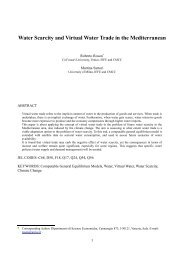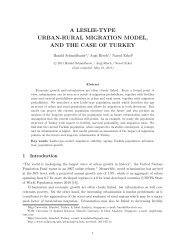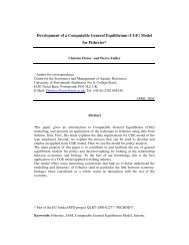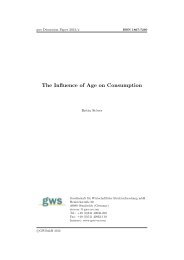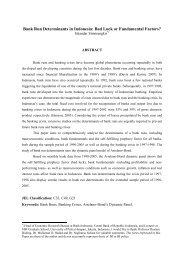Maturity Transformation and Interest Rate Risk in Large European ...
Maturity Transformation and Interest Rate Risk in Large European ...
Maturity Transformation and Interest Rate Risk in Large European ...
Create successful ePaper yourself
Turn your PDF publications into a flip-book with our unique Google optimized e-Paper software.
There are at least three ways that an analyst (say, a regulator) may monitor or assess the <strong>in</strong>terestrate risk of a f<strong>in</strong>ancial <strong>in</strong>termediary. Publicly listed banks <strong>and</strong> <strong>in</strong>surers disclose measures of thesensitivity of their balance sheets to shifts <strong>in</strong> the term structure of <strong>in</strong>terest rates, so <strong>in</strong> the first<strong>in</strong>stance an analyst may refer to these disclosures. These self-reported measures have the advantagethat they may take <strong>in</strong>to account the complex structure of the contracts held by an <strong>in</strong>termediary thatmay not be visible <strong>in</strong> its f<strong>in</strong>ancial statements, but such measures also rely on the will<strong>in</strong>gness <strong>and</strong>ability of the <strong>in</strong>termediary to make an accurate assessment. Furthermore, only one to two measuresare typically disclosed, which cannot be hoped to provide a complete picture of the <strong>in</strong>termediary’sexposure to <strong>in</strong>terest rate changes.As an alternative, the analyst could use regression analysis to measure the sensitivity of the stockreturn of publicly-listed <strong>in</strong>termediaries aga<strong>in</strong>st changes <strong>in</strong> specific <strong>in</strong>terest rates or aga<strong>in</strong>st measuresreflect<strong>in</strong>g the shape of the yield curve. The pr<strong>in</strong>ciple paper <strong>in</strong> this category is Flannery <strong>and</strong> James(1984a), where the authors f<strong>in</strong>d that US banks’ stock returns are sensitive to <strong>in</strong>terest rate changes,<strong>and</strong> that the degree of sensitivity is correlated with the degree of maturity transformation measuredfrom the nom<strong>in</strong>al contracts on their balance sheets. Flannery <strong>and</strong> James (1984b) <strong>in</strong>fer the effectivedegree of maturity transformation based on these stock sensitivity measures. Saunders <strong>and</strong> Yourougou(1990) f<strong>in</strong>d that bank stock returns are more sensitive to <strong>in</strong>terest rate changes than the stock returnsof other companies; they also f<strong>in</strong>d some evidence to suggest that universal banks would be more robustto <strong>in</strong>terest rate changes due to better diversification. Czaja, Scholz, <strong>and</strong> Wilkens (2009) measurethe sensitivity of stock returns of German banks <strong>and</strong> <strong>in</strong>surers to level, slope <strong>and</strong> curvature changes<strong>in</strong> local yield curves, <strong>and</strong> f<strong>in</strong>d that bank <strong>and</strong> <strong>in</strong>surer stock returns offer a premium for those banks<strong>and</strong> <strong>in</strong>surers with greater sensitivities to the level <strong>and</strong> curvature factors. English, van den Heuvel,<strong>and</strong> Zakrajsek (2012) use high-frequency stock <strong>and</strong> <strong>in</strong>terest rate data around Federal Open MarketCommittee announcements to measure the effect of <strong>in</strong>terest rate level <strong>and</strong> slope changes <strong>in</strong> bank stockreturns; study<strong>in</strong>g short time <strong>in</strong>tervals helps to avoid the pollutive effects of unrelated news on stockprices.The analyst could also measure the <strong>in</strong>terest rate sensitivity of each item on the balance sheet, byask<strong>in</strong>g the question “How would the unit prices of the major asset <strong>and</strong> liability categories change if<strong>in</strong>terest rates were different on the valuation date?” This is the approach taken <strong>in</strong> our paper, <strong>and</strong>can be thought of as a ‘prospective’ assessment of <strong>in</strong>terest rate risk, as opposed to the ‘retrospective’assessments follow<strong>in</strong>g Flannery <strong>and</strong> James (1984a). The concepts of duration <strong>and</strong> convexity as measuresof price sensitivity to <strong>in</strong>terest rate changes were <strong>in</strong>troduced by Macaulay (1938), Hicks (1939),Samuelson (1945) <strong>and</strong> Red<strong>in</strong>gton (1952). Houpt <strong>and</strong> Embersit (1991) propose a duration-based methodfor assess<strong>in</strong>g the <strong>in</strong>terest rate sensitivity of banks’ economic value based on their publicly disclosedbalance sheets. This model has s<strong>in</strong>ce become known as the Federal Reserve’s Economic Value Model(EVM). Wright <strong>and</strong> Houpt (1996) evaluate the performance of this simple model for ‘thrift <strong>in</strong>stitutions’aga<strong>in</strong>st a model that uses more detailed private supervisory data, <strong>and</strong> aga<strong>in</strong>st the Office for ThiftSupervision’s <strong>in</strong>ternal model. Despite the limitations of publicly-available data, the authors f<strong>in</strong>d thatthe simple model provides useful <strong>in</strong>formation for measur<strong>in</strong>g the sensitivity of banks’ economic valueto <strong>in</strong>terest rate changes; they also f<strong>in</strong>d that the biggest limitation of such models are the arbitraryassumptions that have to be made about the behaviour of depositors.Jarrow <strong>and</strong> van Deventer (1998) offer a no-arbitrage model for determ<strong>in</strong><strong>in</strong>g the economic valueof deposit contract liabilities, <strong>and</strong> this pric<strong>in</strong>g function could also be used <strong>in</strong> pr<strong>in</strong>ciple to measure itssensitivity to <strong>in</strong>terest rate changes. O’Brien (2000) also offers such a no-arbitrage model, <strong>and</strong> furtherestimates its parameters on US bank data, provid<strong>in</strong>g detailed sensitivity estimates of the economicvalue of bank liabilities to changes <strong>in</strong> the short term <strong>in</strong>terest rate. Sierra <strong>and</strong> Yeager (2004) evaluatethe predictions of the EVM aga<strong>in</strong>st the actual performance of US community banks, which do nottypically engage <strong>in</strong> complex derivative transactions, <strong>and</strong> f<strong>in</strong>d that those banks that the EVM identifiesas most sensitive to ris<strong>in</strong>g rates show the greatest deterioration <strong>in</strong> performance <strong>in</strong> the 1998-2000 periodof ris<strong>in</strong>g rates <strong>in</strong> the US. Sierra (2009) f<strong>in</strong>ds that the ‘prospective’ sensitivities of US bank economicvalue to <strong>in</strong>terest rates calculated from the EVM are consistent with the ‘retrospective’ <strong>in</strong>terest ratesensitivities of stock prices discussed above. Entrop, Memmel, Wilkens, <strong>and</strong> Zeisler (2011) try toproduce a ref<strong>in</strong>ed EVM model calibrated to German bank<strong>in</strong>g data by us<strong>in</strong>g repeated observations ofbalance sheets over time. By evaluat<strong>in</strong>g their model us<strong>in</strong>g private supervisor data, they are able toargue that their model outperforms the EVM, which relies on data at only one po<strong>in</strong>t <strong>in</strong> time. Themost important paper for estimat<strong>in</strong>g the sensitivity of US bank balance sheet derivative exposures is2




